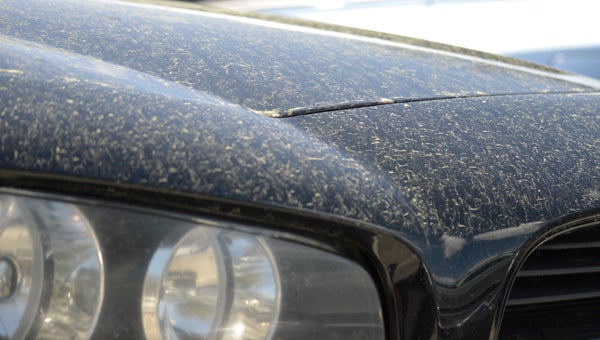Is the pollen done for the season?
Published 7:22 pm Thursday, April 2, 2020

- DAVID CUCCHIARA | DAILY NEWS ALLERGIC REACTION: Pollen buildup is visible on this jet black Dodge Charger.
|
Getting your Trinity Audio player ready...
|
This great question came in this week! I want to assure you, while the office is currently closed, we are still working for you. There have been significant changes to how we do business, offer classes and respond to calls, but North Carolina State Cooperative Extension is still on the job.
Now, down to the business at hand, is the pollen done and can I begin cleaning? The short answer is, no and no, unfortunately.
Riding down the road the other day, my son asked me if all of those little baby pine cones the wind blew down would have become big pine cones. We had had some fairly good wind and many of the little baby pine cones fell from the trees, littering the road. These are flowers of the pine and what produce that pollen, not baby pine cones.
Let’s talk pollen, from one source or another, it is present nearly all year long. The biggest source of pollen right now (late-winter into mid-spring) is coming from pine trees. Typically pine trees, for which eastern North Carolina is known, by the way, are one of the first and heaviest producers of pollen. This is the yellow film that you see on your outdoor furniture, cars, houses and such. We never know exactly when pollen will start to come off of the trees or when it will peak because it is due to the season we are having. I saw pollen on my car this year in mid-February. We can, however, estimate when the peak of the season will be using degree days above 55 degrees beginning Feb. 1. There is a way to look at this data using the State Climate Office online.
To determine degree-days, add the positive differences between the daily high temperature and 55 degrees. When your area reaches 300 degree days, pine trees begin to release pollen. Now hold onto your pants, this is some exciting stuff! When we reach 636 degree days, we have made it to the peak of the pine pollen season.
The season really determines how things will go — some years this is in March and some years this is in May. Overall, the pine pollen season can last for weeks. We can look at the type of day to tell what the pollen count is going to be like, as well. On warm, dry, breezy days, the pollen is going to be much worse. When we have cool, wet periods, it isn’t too bad at all. The time of day is also important. In the morning, there is much more pollen released than in the afternoon.
Why does eastern NC have so many pine trees? Here in the East, we grow pine trees really well. There is an abundance of open land that isn’t suitable for building or crops, so it was developed for the timber industry. We are also home to some of the largest paper mills that make things other than paper, too, by the way! If you have had children in the last 20 years, could you imagine not having disposable diapers? That is another product of the timber industry. North Carolina has a thriving timber industry that has a $32.8-billion impact on our economy.
I would definitely plan to wash everything down, but I would also plan to do it again later in the season, too. Here is a helpful hint to staving off allergies: close your windows during heavy pollen days. But, is it the pine pollen that is bad for you? No, it is usually the pollen from the oak trees that are in bloom at the same time that is causing many of us to suffer from allergies.
If you have a question or concern involving horticulture, email (gene_fox@ncsu.edu) or call me at 252-946-0111. While our office is closed, I am working and ready to help you. I have several restrictions on what I can do, but one of those that is unrestricted is talking on the phone or emailing information to you. As many may have figured out already, our Extension Master Gardener Pass Along Plant sale has been canceled due to statewide and university restrictions. I, along with the Beaufort Extension Master Gardener Volunteers hope you have a wonderful growing season!
Gene Fox is the area consumer horticulture agent with North Carolina Cooperative Extension.





